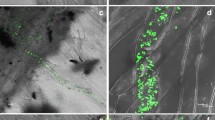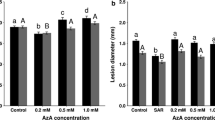Abstract
An inoculation procedure was developed to obtain efficient and synchronous infection on detached tomato leaves by Botrytis cinerea. In spray-inoculated leaves incubated at 20 °C, the infection process consisted of three phases: the formation of primary necrotic lesions (until 20 hpi), a quiescent phase (20-72 hpi), and the expansion of a proportion of the primary lesions (from 72 hpi onwards), resulting in full tissue maceration. At 4 °C, the infection progressed slowly but steadily without inducing necrotic responses in the host. The actin and β-tubulin genes of B. cinerea were cloned, characterized and used as probes on blots containing RNAs from leaves at various stages of the infection. The genes displayed a similar expression pattern throughout the infection and the hybridization signal reflected the amount of fungal biomass. The actin mRNA accumulated to higher levels than the β-tubulin mRNA. Tomato PR protein mRNAs (chitinase, β-1,3-glucanase and PR-1) were induced during the infection, albeit with different kinetics and to different levels. At 20 °C, β-1,3-glucanase and PR-1 mRNAs were induced more rapidly than chitinase mRNAs. At 4 °C, mRNAs encoding extracellular β-1,3-glucanase and intracellular, as well as extracellular chitinase were hardly induced.
Similar content being viewed by others
References
Akutsu K, Ko K and Misato T (1981) Role of conidial fusion in infection by Botrytis cinereaon cucumber leaves. Ann Phytopathol Soc Jap 47: 15-23
Benito EP, Prins TW and van Kan JAL (1996) Application of differential display RT-PCR to the analysis of gene expression in a plant-fungus interaction. Plant Mol Biol 32: 947-957
Broekaert WF, van Parijs J, Allen AK and Peumans WJ (1988) Comparison of some molecular, enzymatic and antifungal properties of chitinases from thorn-apple, tobacco and wheat. Physiol Plant Pathol 33: 319-331
Buhr TL and Dickman MB(1993) Isolation and characterization of a β-tubulinencoding gene from Colletrotrichum gloeosporioidesf. sp. aeschynomene. Gene 124: 121-125
Buhr TL and Dickman MB (1994) Isolation, characterization, and expression of a second β-tubulin-encoding gene from Col- letotrichum gloeosporioidesf. sp. aeschynomene. Applied Environ Microbiol 60: 4155-4159
Clark CA and Lorbeer JW (1976) Comparative histopathology of Botrytis squamosaand B. cinereaon onion leaves. Phytopathology 66: 1279-1289
Couteaudier Y, Daboussi MJ, Eparvier A, Langin T and Orcival J (1993) The GUS gene fusion system (Escherichia coliβ-D-glucuronidase gene), a useful tool in studies of root colonization by Fusarium oxysporum. Applied Environ Microbiol 59: 1767- 1773
Danhash N, Wagemakers CAM, van Kan JAL and de Wit PJGM (1993) Molecular characterization of four chitinase cDNAs obtained from Cladosporium fulvum-infected tomato. Plant Mol Biol 22: 1017-1029
De Waard MA (1997) Significance of ABC transporters in fungicide sensitivity and resistance. Pesticide Science 51: 271-275.
Dudler R (1990) The single copy actin gene of Phytophthora megaspermaencodes a protein considerably diverged from any other known actin. Plant Mol Biol 14: 415-422
Edlich W, Lorenz G, Lyr H, Nega E and Pommer EH (1989) New aspects on the infection mechanism of Botrytis cinereaPers. Neth J Plant Pathol 95 Suppl 1: 53-62
Ekblad A and Nasholm T (1996) Determination of chitin in fungi and mycorrhizal roots by an improved HPL Canalysis of glucosamine. Plant and Soil 178: 29-35
Elad Y (1990) Production of ethylene by tissues of tomato, pepper, French bean and cucumber in response to the infection by Botrytis cinerea. Physiol Mol Plant Pathol 36: 277-287
Elad Y (1992) The use of antioxidants (free radical scavengers) to control grey mould (Botrytis cinerea) and white mould (Sclerotinia sclerotiorum) in various crops. Plant Pathol 41: 417-426
Elad Y and Evensen K (1995) Physiological aspects of resistance to Botrytis cinerea. Phytopathol 85: 637-643
Felix G, Regenass M and Boller T (1993) Specific perception of subnanomolar concentrations of chitin fragments by tomato cells: induction of extracellular alkalinization, changes in protein phosphorylation and establishment of a refractory state. Plant J 4: 307-316
Fidel S, Doonan JH and Morris NR (1988) Aspergillus nidulanscontains a single actin gene which has unique intron locations and encodes a γ-actin. Gene 70: 283-293
Granado J, Felix G and Boller T (1995) Perception of fungal sterols in plants. Plant Physiol 107: 485-490
Grellet F, Delcasso-Tremousaygue D and Delseny M (1989) Isolation and characterization of an unusual repeated sequence from the ribosomal intergenic spacer of the crucifer Sisymbrium irio. Plant Mol Biol 12: 695-706
Hain R, Reif HJ, Krause E, Langebartels R, Kindl H, Vornam B, Wiese W, Schmelzer E, Schreier PH, Stöcker RH and Stenzel K (1993) Disease resistance results from foreign phytoalexin expression in a novel plant. Nature 361: 153-156
Harper AM, Strange RM and Langcake P (1981) Characterization of the nutrients required by Botrytis cinereato infect broad bean leaves. Physiol Plant Pathol 19: 153-167
Jarvis W (1977) Botryotiniaand BotrytisSpecies. Taxonomy and Pathogenicity. Canada Department of Agriculture. Monograph 15
Johnston DJ, Williamson B and McMillan GP (1994) The interaction in plantaof polygalacturonases from Botrytis cinereawith a cell-wall bound polygalacturonase-inhibiting protein (PGIP) in raspberry fruits. J Exp Botany 45: 1837-1843
Joosten MHAJ and de Wit PJGM (1989) Identification of several pathogenesis-related proteins in tomato leaves inoculated with Cladosporium fulvum(syn Fulvia fulva) as β-1,3-glucanases and chitinases. Plant Physiol 89: 945-951
Joosten MHAJ, Bergmans CJB, Meulenhoff EJS, Cornelissen BJC and de Wit PJGM (1990) Purification and serological characterization of three basic 15 kD pathogenesis-related proteins from tomato. Plant Physiol 94: 585-591
Joosten MHAJ, Verbakel HM, Nettekoven ME, van Leeuwen J, van der Vossen RTM and de Wit PJGM (1995) The phytopathogenic fungus Cladosporium fulvumis not sensitive to the chitinase and β-1,3-glucanase defence proteins of its host tomato. Physiol Mol Plant Pathol 46: 45-59
Leone G (1990) In vivoand in vitrophosphate-dependent polygalacturonase production by different isolates of Botrytis cinerea. Mycol Res 94: 1039-1045
Levine A, Tenhaken R, Dixon R and Lamb C (1994) H2O2 from the oxidative burst orchestrates the plant hypersensitive disease resistance response. Cell 79: 583-593
Linthorst HJM (1991) Pathogenesis-related proteins of plants. Crit Rev Plant Sci 10: 123-150
Luck JE and Gillings MR (1995) Rapid identification of benomyl resistant strains of Botrytis cinereausing the polymerase chain reaction. Mycol Res 99: 1483-1488
Mahe A, Grisvard J and Dron M (1992) Fungal-and plant-specific gene markers to follow the bean anthracnose infection process and normalize a bean chitinase mRNA induction. Mol Plant-Microbe Interact 5: 242-248
May GS, Gambino J, Weatherbee JA and Morris NR (1985) Identification and functional analysis of beta-tubulin genes by site specific integrative transformation in Aspergillus nidulans. J Cell Biol 101: 712-719
May GS, Tsang ML-S, Smith H, Fidel S and Morris NR (1987) Aspergillus nidulansβ-tubulin genes are unusually divergent. Gene 55: 231-243
McClellan WD and Hewitt WB (1973) Early Botrytisrot of grapes: time of infection and latency of Botrytis cinereaPers. in Vitis viniferaL. Phytopathology 63: 1151-1157
Neff NF, Thomas JH, Grisafi P and Botstein D (1983) Isolation of the β-tubulin gene from yeast and demonstration of its essential function in vivo. Cell 3: 211-219
Niderman T, Genetet I, Bruyere T, Gees R, Stintzi A, Legrand M, Fritig B and Mösinger E (1995) Pathogenesis-related PR-1 proteins are antifungal. Plant Physiol 108: 17-27
Ng R and Abelson J (1980) Isolation and sequence of the gene for actin in Saccharomyces cerevisiae. Proc Natl Acad Sci USA 77: 3912-3916
Oliver RP, Farman ML, Jones JDG and Hammond-Kosack KE (1993) Use of fungal transformants expressing β-glucuronidase activity to detect infection and measure hyphal biomass in infected plant tissues. Mol Plant-MicrobeInteract 6: 521-525
Orbach MJ, Porro EB and Yanofsky C. (1986) Cloning and characterization of the gene for β-tubulin from a benomyl-resistant mutant of Neurospora crassaand its use as a dominant selectable marker. Mol Cell Biol 6: 2452-2461
Padgett DE and Posey MH (1993) An evaluation of the efficiencies of several ergosterol extraction techniques. Mycol Res 97: 1476- 1480
Pezet R, Pont V and Hoang-Van K (1991) Evidence for oxidative detoxification of pterostilbene and resveratrol by a laccase-like stilbene oxidase produced by Botrytis cinerea. Physiol Mol Plant Pathol 39: 441-450
Pieterse CMJ, Verbakel HM, Hoek Spaans J, Davidse LC and Govers F (1993) Increased expression of the calmodulin gene of the late blight fungus Phytophthora infestansduring pathogenesis on potato. Mol Plant-Microbe Interact 6: 164-172
Pineiro M, Garcia-Olmedo F and Diaz I (1994) Redox modulation of the expression of bacterial genes encoding cysteine-rich proteins in plant protoplasts. Proc Natl Acad Sci USA 91: 3867-3871
Prusky D (1996) Pathogen quiescence in postharvest diseases. Ann Rev Phytopathol 34: 413-434
Rebordinos L, Cantoral JM, Prieto MV, Hanson JR and Collado IG (1996) The phytotoxic activity of some metabolites of Botrytis cinerea. Phytochemistry 42: 383-387
Salinas J and Verhoeff K (1995) Microscopical studies on the infection of gerbera flowers by Botrytis cinerea. Eur J Plant Pathol 101: 377-386
Sambrook J, Fritsch EF and Maniatis F (1989) Molecular Cloning: A Laboratory Manual, 2nd ed. Cold Spring Harbor Laboratory Press; Cold Spring Harbor, NY
Van den Ackerveken GFJM, van Kan JAL, Joosten MHAJ, Muisers JM, Verbakel HM and de Wit PJGM (1993) Characterization of two putative pathogenicity genes of the fungal tomato pathogen Cladosporium fulvum. Mol Plant-Microbe Interact 6: 210-215
Van den Heuvel J (1981) Effect of inoculum composition on infection of French bean leaves by conidia of Botrytis cinerea. Neth J Plant Pathol 87: 55-64
Van den Heuvel J and Waterreus J (1985) Pectic enzymes associated with phosphate-stimulated infection of French bean leaves by Botrytis cinerea. Neth J Plant Pathol 91: 253-264
Van der Vlugt-Bergmans CJB, Wagemakers CAM and van Kan JAL (1997a) Cloning and expression of the cutinase Agene of Botrytis cinerea. Mol Plant-Microbe Interact 10: 21-29
Van der Vlugt-Bergmans CJB, Wagemakers CAM, Dees DCT and Van Kan JAL (1997b) Catalase A from Botrytis cinereais not expressed during infection on tomato leaves. Physiol Mol Plant Pathol 50: 1-15
Van Kan JAL, Joosten MHAJ, Wagemakers CAM, van den Berg-Velthuis, GCM and de Wit PJGM (1992) Differential accumulation of mRNAs encoding extracellular and intracellular PR proteins in tomato induced by virulent and avirulent races of Cladosporium fulvum. Plant Mol Biol 20: 513-527
Van Kan JAL, Cozijnsen AJ, Danhash N and De Wit PJGM (1995) Induction of tomato stress protein mRNAs by ethephon, 2,6dichloroisonicotinic acid and salicylate. Plant Mol Biol 27: 1205- 1213
Van Kan JAL, van 't Klooster JW, Dees DCT, Wagemakers CAM and van der Vlugt-Bergmans CJB (1997) Cutinase A of Botrytis cinereais expressed, but not essential, during penetration of gerbera and tomato. Mol Plant-Microbe Interact 10: 30-38
Verhoeff K (1970) Spotting of tomato fruits caused by Botrytis cinerea. Neth J Plant Pathol 76: 219-226
Verhoeff K and Liem JI (1975) Toxicity of tomatine to Botrytis cinerea, in relation to latency. Phytopathol Zeitschrift 82: 333- 338
Von Tiedemann A (1997) Evidence for a primary role of active oxygen species in induction of host cell death during infection of bean leaves with Botrytis cinerea. Physiol Mol Plant Pathol 50: 151-166
Williamson B (1994). Latency and quiescence in survival and success of fungal plant pathogens. In: Ecology of Plant Pathogens, Blakeman JP and Williamson B (eds), pp. 187-207. CAB International, Oxford
Wubben JP, Lawrence CB and de Wit PJGM (1996) Differential induction of chitinase and β-1,3glucanase gene expression in tomato by Cladosporium fulvumand its race-specific elicitors. Physiol Mol Plant Pathol 48: 105-116
Yarden O and Katan T (1993) Mutations leading to substitutions at amino acids 198 and 200 of beta-tubulin that correlate with benomyl-resistance phenotypes of field strains of Botrytis cinerea. Phytopathology 83: 1478-1483
Author information
Authors and Affiliations
Rights and permissions
About this article
Cite this article
Benito, E.P., ten Have, A., van 't Klooster, J.W. et al. Fungal and plant gene expression during synchronized infection of tomato leaves by Botrytis cinerea. European Journal of Plant Pathology 104, 207–220 (1998). https://doi.org/10.1023/A:1008698116106
Issue Date:
DOI: https://doi.org/10.1023/A:1008698116106




